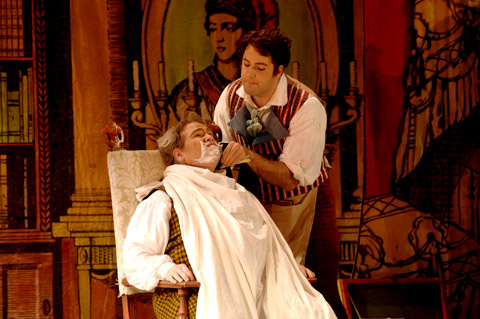
WINK, WINK For farce to work, we need to believe in the characters’ desperation; and in this production, we don’t. |
In his program note for the Boston Lyric Opera production of Rossini's effervescent The Barber of Seville (Shubert Theatre, through March 18), music director David Angus asks us to listen extra carefully to this irresistible score, however familiar it may be. If only stage director Doug Varone had followed Angus's advice.Take the famous overture. Rossini recycled it from an opera about Queen Elizabeth I. But its mixture of the sinister and the fizzy must have seemed right as an introduction to this opera buffa — his setting of Beaumarchais's play about a clever barber plotting to bring two lovers together (Fellini used this music brilliantly for the unsettling spa scene in 8 1/2). Varone resorts to the tired cliché of staging the overture, as if the last thing an opera audience wants is to listen to music. But what do we see?— a large portrait of the composer, a dangling scale model of a theater, and, mostly, a washerwoman and her aged assistant mopping the stage: an activity that in no way reflects the exhilaration and wit of the music.
Varone keeps undermining Angus's expert comic pacing. The orchestra keeps revving up for breathless climaxes while the stage action fizzles. There's barely a moment of genuine tension or suspense. He also ignores the words. He has Rosina, the heroine (in her bordello-red boudoir!), devote her entire aria of love and defiance to painting (on an easel) what turns out to be a caricature of her despised guardian. Her body language and facial expression have nothing to do with what she's singing.
Allen Moyer's opera-within-an-opera sets borrowed from the Minnesota Opera (flat backdrops, fake footlights, chandeliers, even painted box seats with painted audience members), distance us even further. We're not watching people with "real" problems but singers pretending to be characters in an opera — a post-modern contrivance that, instead of allowing us to empathize with the plight of the characters, pushes us away. The essence of farce is that however ridiculous the plot, the characters believe that their lives depend on succeeding. If the performers keep winking at the audience, how can we believe their desperation? Why should we care? And in this production, I don't think we do.
There's some good singing — especially from coloratura soprano Sarah Coburn, with her delightfully agile trills and warm peaches-and-cream tone. But is her Rosina really desperately in love with the student Lindoro (the Count Almaviva in disguise)? And does Almaviva , the refined but sporadically toneless Canadian tenor John Tessier, care anything for Rosina? There's just no chemistry.
As the dexterous barber, baritone Jonathan Beyer certainly spits out the consonants in his famous "Largo al factotum" (a/k/a "Figaro! Figaro! Figaro!"), but he seems less a wily servant than an affable Animal House jock. The most believable performance is by portly buffo baritone Steven Condy as Dr. Bartolo, Rosina's frustrated and ultimately outwitted guardian. You rooted for him rather than the faceless lovers. His hilarious imitation of an operatic castrato is a gem. The weirdest singing, though, comes from Judith Christin as the servant Berta, who was probably cast because of her jolly girth (picture Downton Abbey's Mrs. Patmore). But wobbly top notes and basso chest tones sound more like a female impersonator than a mezzo-soprano.